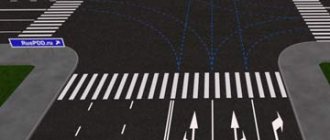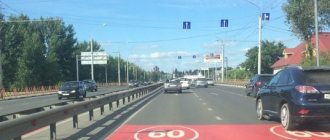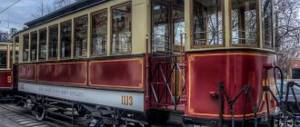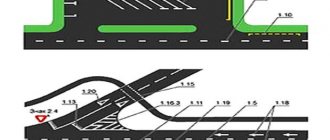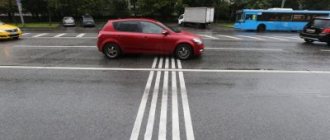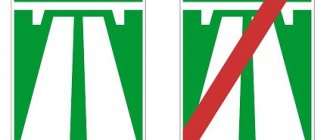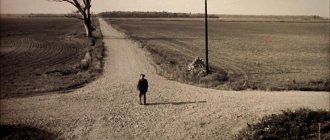Are you allowed to continue driving in the right lane in a passenger car?
| 1. | Forbidden. |
| 2. | Permitted if it does not interfere with the movement of route vehicles. |
| 3. | Permitted if the speed of the truck is less than 30 km/h. |
You are prohibited from such a maneuver, since the movement of other vehicles is prohibited in the dedicated lane, marked with the sign “Lane for route vehicles” and markings 1.23.1.
Driving in a dedicated lane on weekends
Let's consider another interesting situation that occurs on the roads. For example, in Moscow some bus lanes do not operate on weekends. To do this, the following combination of road signs is installed:
This combination of signs means that the lane is dedicated only on weekdays . That is, you can drive along it on weekends.
However, the following factors must be taken into account:
- Additional conditions prohibiting departure. For example, if a 3.1 “brick” sign is installed above a dedicated lane, then driving into this lane is prohibited (both on weekdays and on weekends).
- Solid marking line. On weekends, only the bus lane ceases to operate, and the solid marking line separating it remains in place and you cannot cross this line. That is, the driver can receive a fine for crossing a continuous line, although driving along the lane is not prohibited.
- Is the day a holiday? The most difficult situation arises when weekends are postponed. For example, if Saturday is declared a working day, then traveling to the bus lane on that day is prohibited.
How do you know if you can drive in a dedicated lane today?
To find out whether the current day is a working day or a weekend, you will have to refer to the regulatory documents.
First of all, let's look at Article 112 of the Labor Code:
Non-working holidays in the Russian Federation are: January 1, 2, 3, 4, 5, 6 and 8 - New Year holidays; January 7—Christmas Day; February 23 - Defender of the Fatherland Day; March 8—International Women's Day; May 1 - Spring and Labor Day; May 9 - Victory Day; June 12—Russia Day; November 4 is National Unity Day.
If a day off coincides with a non-working holiday, the day off is transferred to the next working day after the holiday, with the exception of weekends coinciding with non-working holidays specified in paragraphs two and three of part one of this article. The Government of the Russian Federation transfers two days off from the number of days off that coincide with non-working holidays specified in paragraphs two and three of part one of this article to other days in the next calendar year in the manner established by part five of this article.
In addition, weekends may be postponed in additional regulatory documents. In 2021, this information is provided in the Decree of the Government of the Russian Federation of October 14, 2021 N 1250 “On the transfer of holidays in 2021”:
Move the following holidays to 2021:
from Saturday 6 January to Friday 9 March; from Sunday January 7 to Wednesday May 2; from Saturday 28 April to Monday 30 April; from Saturday 9 June to Monday 11 June; from Saturday 29 December to Monday 31 December.
In 2021, the Decree of the Government of the Russian Federation of October 1, 2021 N 1163 “On the transfer of days off in 2021” is in force:
Move the following holidays to 2021:
from Saturday 5 January to Thursday 2 May; from Sunday 6 January to Friday 3 May; from Saturday 23 February to Friday 10 May.
Please note that every year a new Government decree is issued on postponing holidays.
Unfortunately, in practice, moving holidays causes problems for some drivers. We are mainly talking about those who do not work a standard working week, because... They have to monitor the holidays on their own.
For example, December 29, 2021 (Saturday) is a working day. Drivers who drove onto designated lanes in Moscow that day received appropriate fines.
The situation repeats itself from year to year, so be careful.
Are you allowed to stop at the indicated place?
| 1. | Prohibited. |
| 2. | Permitted only for boarding or disembarking passengers. |
| 3. | Permitted if there is no interference with the movement of route vehicles. |
You cannot stop at the indicated place, since the sign “Road with a lane for route vehicles” and the marking “A” indicate that the left lane is used for oncoming traffic only by route vehicles. It is prohibited to enter this lane and stop on it (18.2 traffic rules).
Why are there crooked markings on Russian roads?
We can say with a high degree of confidence that many road users are familiar with such strange lines, as if the team that applied them to the road surface was not entirely sober. Most often, you can find such markings either on the outskirts of the city or in rural areas. The origin of such markup. At first, many drivers believed that such markings were applied by accident and wondered why such interesting designs were painted on the road. When trying to find out where such lines came from, it turned out that this was planned. This information was shared by one of the workers who took part in its application. Why are these drawings applied in this way?
It is not difficult to guess why the markup is done this way, although few can do it. Performing this action is done only where there are practically no passing cars or passing pedestrians. The answer to the above question turned out to be much simpler, and even correct. Similarly, road workers set up and calibrate a special road marking machine. This is done in places where there are few cars. To do this, a certain area is selected, on which a sample is drawn. The reason for such actions is the lack of a special testing ground, although there should be one.
During such tests, there is no person constantly pressing the button in the marking machine to ensure that the line is intermittent. The fact is that it is simply impossible to obtain such even segments and intervals manually, so for these purposes a special computer program written for specific markings is installed in the machine. The parameters that the computer needs to know to run the selected program are the length of the marked area, the frequency of breaks or their absence when drawing a solid line, and the required paint supply speed.
Reasons for inconsistencies. In addition, the second source of information when applying road markings are special road maps provided by the city leadership. For this reason, inconsistencies with the required number of stripes may appear. For example, at first there were three of them, about 2.5 meters wide. After some time, the decision was made to make the lanes narrow, so the road workers are not to blame either.
Other possible marking options. The lane on the left may abruptly go into the curb, which is why it is necessary to trim the width of one lane. And there may be several such places in one average city. Complaints from vehicle drivers to various authorities have no effect, just as specially deciphered statistics of emergency situations have no impact.
In the current situation, in order to save money and successfully utilize the allocated funds, road markings, regardless of the area, are applied using ordinary paint. If we consider the correct technology, approved by all documents and standards, then the application of such markings should be carried out using liquid plastic. The advantage of this method is that road markings applied in this way last much longer. If you apply road markings with paint, then under the influence of mechanical stress and weather factors it will be erased after a maximum of three months, after which road services are required to apply it again.
Bottom line. Unevenness of the applied markings can be caused by several factors. First, this area with virtually no traffic was chosen to calibrate and set up the marking machines. Secondly, this section of the road is uneven in itself, as a result of which the number and width of lanes have to be changed.
You are allowed to continue driving:
| 1. | Only along trajectory A. |
| 2. | Only along trajectory B. |
| 3. | Along trajectories A and B. |
| 4. | Along trajectories B and C. |
| 5. | Along any trajectory from those indicated. |
You can continue moving only along trajectory B, since by turning along trajectory A, you will not comply with the requirement to move as close as possible to the right edge of the roadway, and continuing further movement along the lane for route vehicles along trajectory B is prohibited.
Drunk zebra
Almost all Russian cities were built according to Soviet standard designs, the inconvenience and inconsistency with the conditions of modern traffic have become especially noticeable recently.
But instead of somehow influencing the situation, highway workers continue to aggravate it in every possible way, because why, for example, move several elements of park fences and duplicate a parallel crossing, if you can give it the shape of a ladder, thereby violating not only traffic rules, but also all known geometric laws.
Which driver stopped correctly to unload passengers?
| 1. | Only A. |
| 2. | Only in. |
| 3. | A and B. |
| 4. | B and V. |
- On the left side of one-way roads (one-way road sign) in populated areas, stopping and parking of vehicles is allowed (where driver “A” stopped).
- On roads with a lane for route vehicles (sign 5.14, markings in the form of the letter “A”), driving and stopping other vehicles in this lane (where driver “B” stopped) is prohibited.
- Passengers should board and disembark from the sidewalk or curb, and not in the middle of the roadway where driver “B” stopped.
Therefore, only driver “A” did not violate.
Vertical marking
When driving, vertical objects are usually visible as well. They become more pronounced due to vertical markings. It is also numbered.
So, the vertical marking is presented:
2.1.1 – 2.1.3 – usually applied to poles and other high vertical objects on the road.
2.2 – used on the lowest edge of structures if they are located above the road.
2.3 – necessary to designate rounded objects. They are usually located in the middle of the road to separate traffic going in different directions.
2.4 - also used on small rounded posts, but to determine the direction.
2.5 - often found on rounded bridges, as well as when driving in the mountains and other dangerous areas.
2.6 – used on fences that are installed on straight sections of roads.
2.7 – applied on curbs to make them easier to see.
Of course, there are fewer vertical markings, but their role is very important, especially at night. Thanks to it, many objects become better visible. So that it does not harm motorists, but, on the contrary, is useful, when applying it, GOST Road markings must be observed.
Markings in the form of the letter “A” indicate:
| 1. | A special lane for all buses. |
| 2. | A special lane for route vehicles. |
| 3. | Stopping and parking place for any buses. |
Markings in the form of the letter “A” indicate a special lane intended for the movement of route vehicles, i.e. buses and trolleybuses moving along established routes with designated stopping places.
This sign indicates that:
| 1. | You must turn right or left. |
| 2. | Reversible traffic is organized on the road being crossed. |
| 3. | There is one-way traffic on the road being crossed. |
Before you is an intersection where reverse regulation is carried out in the middle lane of the road being crossed, i.e. the direction of movement can be reversed. You are informed about this by the “Exit onto a road with reverse traffic” sign and double broken lines marking the boundaries of the middle lane.
Is the driver allowed to stop at this location to unload the vehicle?
| 1. | Allowed. |
| 2. | It is allowed if the stop takes no more than 5 minutes. |
| 3. | It is allowed if there is no interference with the movement of route vehicles. |
| 4. | Prohibited. |
If the lane for route vehicles (marking 1.23.1) is separated from the rest of the roadway by a broken line of markings, then it is allowed to enter and stop on such a lane at the right edge of the roadway to board and disembark passengers, provided that no interference is created. route vehicles (traffic regulations 18.2). Stopping on such a lane for other purposes, in particular for loading and unloading, is prohibited.
Is it possible to cross a continuous line? Why was it invented?
It is important to immediately make a reservation that there is no definite answer as to whether it is possible to cross a continuous line, since this depends on the current road situation, since there are points of the rules that allow you to cross the line, they will be discussed below. This line was developed and put into operation solely because it is the most convenient visual means to date for regulating and controlling the movement of vehicles. Many drivers note that it is much easier to drive on marked roads, “you don’t have to guess” how the lanes are marked, and fewer accidents occur. This does not exclude the possibility that you may encounter places where there are no lines on the road surface at all (we are talking about rural roads, urban-type settlements, small settlements in remote regions, roads under construction or abandoned, etc.). Regarding this, detailed instructions are given in the traffic rules and there is an action plan for this (driving on roads that do not have markings).
Pedestrian...dead end
And again the story is about metal fences, which sometimes give the impression of being firmly dug into the ground.
Judging by the photo, the young woman with a stroller, moving to the left, still sees some kind of passage in front of her, otherwise she and the pensioners following her would have to remember their physical education lessons, demonstrating the skills of jumping over a goat at speed.
Caroline transition
This creation will drive anyone crazy, more reminiscent of a living illustration from “Alice in Wonderland” than an ordinary intersection. What adds to the piquancy of the situation is that not a single zebra ever received its logical conclusion.
Although if we assume that the designer dabbled in magic mushrooms, like the main character of Lewis Carroll's fairy tale, then one should not be surprised at such a result.
